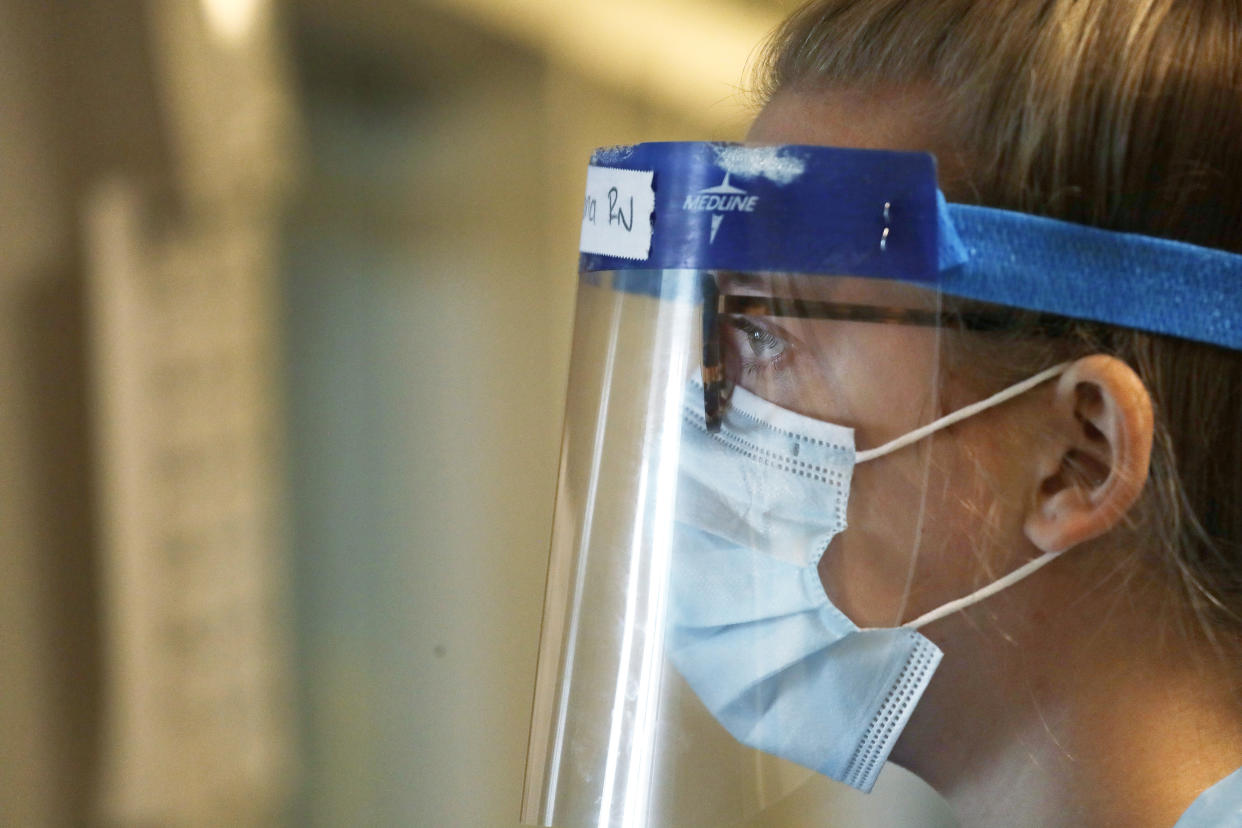Face shields vs. face masks — here’s which one experts prefer

The Centers for Disease Control and Prevention has held firm in its recommendations for how Americans can protect themselves and others from the coronavirus: Stay six feet apart, wash hands frequently and — especially when social distancing is impossible — wear a face mask. But increasingly, epidemiologists and experts in prevention are recommending something new: Add a face shield, too.
A face mask, which can be surgical-grade or made of cloth (and ideally contains three layers), typically covers the nose and mouth and loops around the ears. The personal protective equipment has become standard in the medical field — and now, in many cities nationwide. For good reason: According to the Mayo Clinic, a proper face mask filters out “large particles in the air,” and has been shown to reduce the spread of COVID-19 by 85 percent.
But while face masks may provide great protection to others, face shields seem to provide great protection to those wearing them. Typically made up of a piece of clear plastic that extends down from the top of the head, they not only cover the mouth and nose but the eyes too, a part of the body through which the coronavirus can also be transmitted. In an April editorial published by Cambridge University, experts argued that they offer “better coverage of the face,” by “protect[ing] the facial area and associated mucous membranes from infectious droplets and spatter of body fluids.”
Video: Should we be wearing masks or face shields?
Shields come with a host of other benefits too. “Face shields are durable, and they can be cleaned and reused,” the authors of the Cambridge paper write. “Given their simpler design, durability, and reuse potential, face shields are less likely to be in short supply, like face masks. Additionally, face shields do not impede facial nonverbal communication; they can be worn concurrently with other face and eye-protective equipment, and they do not impact vocalization.”
Dr. Eli Perencevich, a professor of internal medicine and epidemiology at the University of Iowa Carver College of Medicine, has been touting the benefits of face shields for months. In particular, he thinks they would be useful for essential workers to wear on top of masks. “If you are working in a high-risk environment, so for example at a grocery store or in a restaurant, I think those employees should be wearing both [a face mask and a face shield] to protect others and themselves,” Perencevich tells Yahoo Life. “Mask for others, face shield for themselves. I think that's clearly the best workplace safety.”
Perenecevich also believes shields could be useful in the education system. “Singapore has done the most research on this and they've mandated face shields for kids up to age 12 in school,” he says. “So I think we have to get these shields to young kids because I don't think kids can wear masks effectively.”
In a paper published in JAMA in April, Perencevich and two others elaborated on why this form of PPE has major advantages. “While medical masks have limited durability and little potential for reprocessing, face shields can be reused indefinitely and are easily cleaned with soap and water, or common household disinfectants,” they write. “They are comfortable to wear, protect the portals of viral entry, and reduce the potential for autoinoculation by preventing the wearer from touching their face.”
The authors note that while more research is needed, one study showed that they may be capable of preventing 96 percent of droplets from reaching your face. On top of this, they add that individuals may be less likely to take it off or pull it down, a style New York Governor Andrew Cuomo recently dubbed a “chin guard.” “People wearing medical masks often have to remove them to communicate with others around them; this is not necessary with face shields,” the paper reads. “The use of a face shield is also a reminder to maintain social distancing, but allows visibility of facial expressions and lip movements for speech perception.”
Perencevich says that, given all these benefits, he’s surprised with the CDC’s stance — which does not recommend them. “There’s not perfect data, but there's pretty good data,” he says. But the CDC’s reasoning seems to be that face shields may not provide “source control” (meaning may not protect you from spreading the virus to others), which may bear some truth.
Dr. Saski Popescu, a renowned infection prevention epidemiologist at George Mason University, agrees that they contain many benefits, but stresses that more research is needed. “Face shields have a lot of great advantages, like full-face protection, which is more than masks in terms of coverage, but there really haven’t been studies on source control,” Popescu tells Yahoo Life. “So while they protect the person wearing them, we can’t say how much they protect other people, which is why we have community mask recommendations. Ideally, you’d want a mask and eye protection.”
For the latest coronavirus news and updates, follow along at https://news.yahoo.com/coronavirus. According to experts, people over 60 and those who are immunocompromised continue to be the most at risk. If you have questions, please reference the CDC’s and WHO’s resource guides.
How to maintain your physical and mental health during the pandemic
Taking care of a loved one with COVID-19? Here’s how to stay healthy
Q&A with Dr. Kavita Patel: How to keep your family safe and maintain your mental health
Read more from Yahoo Life
Sleep deprivation from nightly fireworks 'can be viewed as torture,' doctor says
What's the difference between a 2nd wave and 2nd peak of COVID-19?
Pregnant women with coronavirus: New study finds majority were ‘asymptomatic’
Want daily lifestyle and wellness news delivered to your inbox? Sign up here for Yahoo Life’s newsletter
